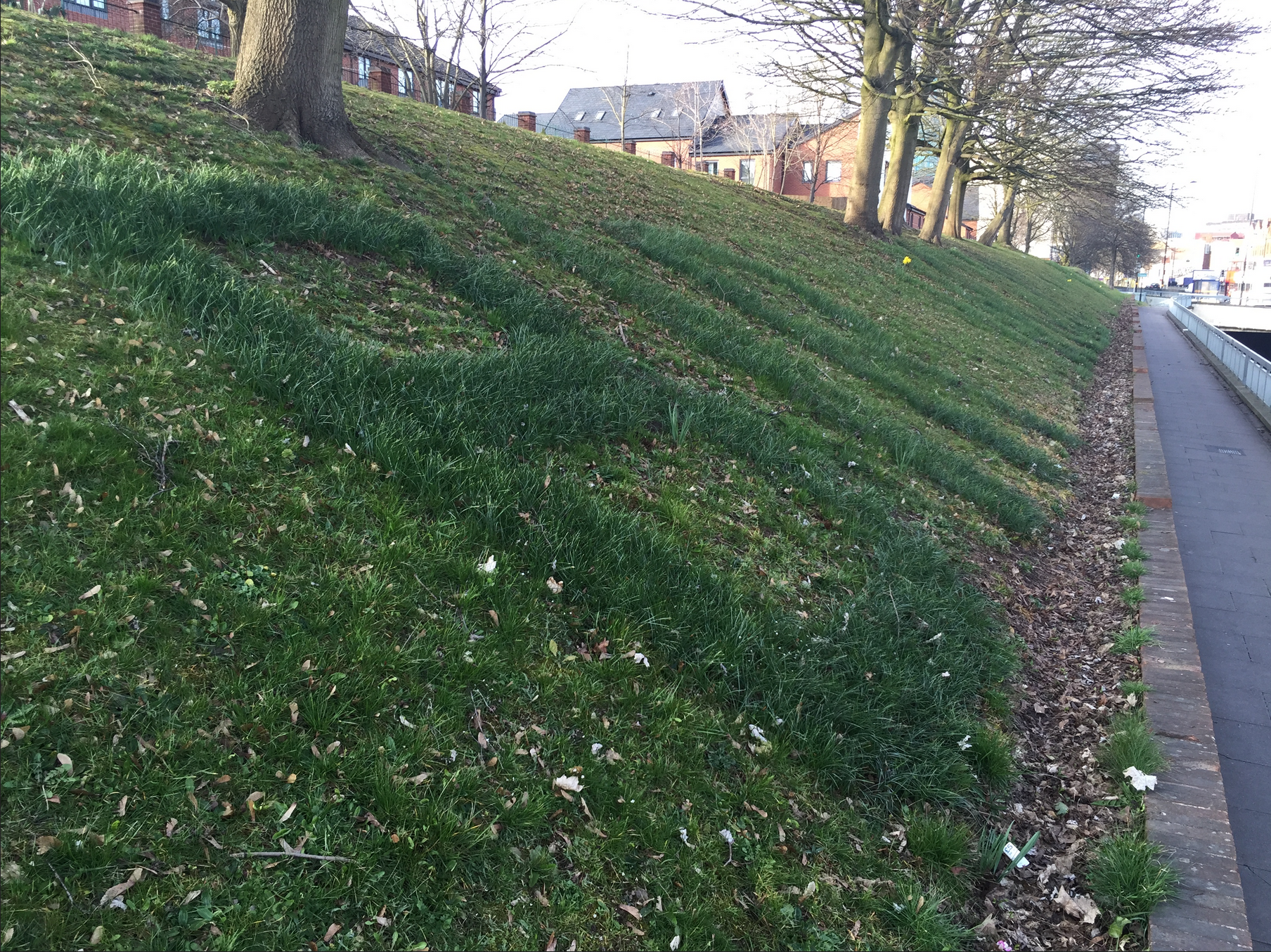Jane and the City: Jane’s Walks Come to Brum.
I learnt about Jane’s Walk about two years ago: citizen-led guided tours that anyone who cares about their locale can lead. Jane being Jane Jacobs, influential US town planner and author of The Death and Life of Great American Cities. The tours are an international memorial to perpetuate her life’s values, all happening over one weekend. Alan Bain of JMP introduced me to Jane’s Walks and on closer inspection, they very closely paralleled Still Walking in many aspects. The key one being: arranging a temporary outdoor forum for discussing our surroundings and how they affect us.
It’s interesting to see which cities have a programme: it’s not always those which have an active tourist guided tour presence. In the UK, York, Cambridge, Oxford and Edinburgh have yet to run one but Birmingham, Bradford, Coventry and Stoke all feature prominently. Obviously, these walks are for doing something other than sight seeing.
The idea behind my walk along Bristol Road / Street was to experience at walking pace an arterial road more usually experienced by bus or car. Would there be anything worth visiting? Several people showed up after work on Friday to find out.
The moments which intrigued the group were unexpected. We debated for 10 minutes why the Ethiopian restaurant was called Shamrock: was it a sign of ethnic integration? Were there shamrocks in Ethiopia and were they lucky / edible? Two members of the group volunteered to dine there soon and report back. Another restaurant sign mystery appeared later: why was the drive-thru McDonalds sign a) green and b) tiny to the point of unreadable? There were more questions than answers. Two of the group lived nearby and were the only people present who had walked the full length of the road. This couple remembered the Superprix in the 1980s – a trace of which was still visible, spelling out ‘Birmingham’ in crocus greenery. In the private housing estate, we looked at some amazing sculptural details: goblins appeared to be offering a pig to a prone figure. Easter Island heads loomed over the entrances to the 15 blocks. We were joined by a member of the residents’ committee, curious about our curiosity, and able to provide details I hadn’t googled before setting out. Our final destination was a large but empty hotel. It advertised a fishing lake and beer garden, both of which would have been welcome in this ‘dry’ residential area. When I left the walk, several of the group appeared to be working out how to break in to investigate further.
Flowers for Drivers
The Saturday morning walk was another ‘long street’ showcase, led by Dr Dave Richardson. Dave works with the My Route project – highlighting the history and heritage of the first few miles of Stratford Road. A compact group gathered to find out more. The route instantly took us to unfamiliar territory: the former James Bicycle Factory – a well preserved Victorian delight in Lombardic Romanesque style. The famous Vale-Onslow motorcycle shop was next: the scaffolding and greenery in the brickwork suggested it was long closed but surprisingly it was still trading. Like the Diskery we visited yesterday, this shop had at some unnoticed point become a museum to itself. Similarly, the last stand of the Irish community in the area is represented by Bourke’s grocers. Its crucifixes, sacks of Irish potatoes (Rooster, Kerrs Pink and Golden Wonder) feel like carefully curated exhibits. What became apparent on this walk is how much I’d missed in the past – and I’m usually on the look-out for these details. I’d even combed the street with David earlier in the year. But being in a group, observing and talking seems to make features pop out of the urban fabric, and their meaning more apparent. Our walk ended at the Antelope – a beautiful Arts and Crafts former pub with a huge William Bloye relief panel of an Antelope. The building is now Hajees Spices, which whilst resolutely ‘dry’ still recognises and preserves the beauty of the pub’s decoration and ornate M&B lettering. No single moment better characterises the social changes at work in the area.
Doctor Foot
On Sunday morning, Fin Skillen introduced us to the world of the Cycle Courier. The courier needs to know the city inside out but in a different way to taxi drivers’ (erstwhile) knowledge of street names. Short cuts, near misses and road network savviness in a city designed specifically for cars are all essential components. Fin explained the routes he took were against the clock and needed to avoid red lights whenever possible. During multi-drops, joining the dots meant understanding that shortest wasn’t necessarily quickest, required keeping gravity on your side and knowing where to chain up in safety. Fin showed us many snipped padlocks and wholly removed Sheffield stands – indices of where to avoid locking up. Cycling all day means a ferocious calorie burn and knowing where the cheap sandwiches are is critical. Samples and street-distributed freebies are common once you know where to go – our group were treated to the taste of new banana flavour Soreen, handed out in Centenary Square to the 10k race runners. This also proved to be a history walk: in the three years since he last worked as a courier, the city has changed significantly and many of Fin’s short cuts no longer are possible. Even taking a few days away from the fervent urban upheaval is enough to put you at a disadvantage.
A single malt
Lost and Found: Sport and the City on Monday was Alan Bain’s walk of the lost sports fields of Bearwood – a curious cluster of these appearing along City Road. Alan played on many of these fields just 15 years ago but it must have felt more like 50 to see so many of them grown over and sealed off. Our first field was the Avery Sports Ground on City Road, a recreation ground originally created for employees of Avery weighing scales manufacturers. It’s been unused since 1979 1995 with no evidence of its imminent future reuse. The scale is epic and there’s a real atmosphere of loss and lost opportunity on tennis courts, cricket pitches and football fields still visible beneath the growth. Apart from the obligatory blue bottle of Frosty Jack at the gate, there is little evidence that anyone in using the space in any way. Another clue is the notice served up by GRC Bailiffs a year ago advising on horses that had been detained on the land.
Our next lost grounds has been built over completely. David Wilson Homes have convincingly recreated a village of six bedroom houses over the former sports ground: ‘Lordswood Gardens, Harborne’ (although we are still in Bearwood). Some space has been preserved as a village green effect and meadow. The national shortfall in new houses means sports ground become the equivalent of inner city green belt. We visit two other sites: a cricket field formerly belonging to the M&B’s Cape Hill Brewery in a transitional phase, and a football field overgrown but with goal posts and floodlights still standing. Street names reflect the M&B logo: Stag Road, Antler Way, Roebuck Road.
Lost Home Games of Birmingham
The final walk on Monday afternoon is more a survey of how street furniture has been adapted to confound skateboarders in Eastside City Park. Since the closure of the ramp at the Custard Factory in February, this is the skaters’ last refuge in the city. Even before the park officially opened, the skaters had been in and were waxing down the steps stone edges for their tricks. For this event I had invited Mark Preston from Ideal Skates to lead a brief walk around the area and show how various extra bits of metal were being added to the stone work. I’d spotted the metal knobs appearing but had missed a more subtle feature: lengths of metal inserted between stone slabs to deliberately scupper small hard wheels’ progress. Other park users hadn’t missed them: there were a few pedestrian stumbles from time to time. It appeared that skaters merely adapt their technique to the new obstacles. I had heard about tools created to remove the knobs and Mark confirms he’d previously discovered knobs which would simply pull out and could be replaced neatly after use.
Whatever your take on skating, there are many who come specifically to the park to watch their tricks and who may stay on in the area to do something else, economically. One problem in the park is litter. We’d previously identified the positioning of a large litter bin at the end of a low-level wall as a deliberate effort to thwart skaters jumping off the end. A chance encounter with a park committee member revealed the positioning was accidental – it was merely to make depositing litter in it more likely. The true situation is that the young skaters hate the bin and won’t use it to protest its presence. This Jane’s Walk revealed the subtle and unknowable rhythms, rules and intentions of city space and how making them overlap by public forum, even on a small informal scale can yield beneficial results.
Park life





